French firm Venturi may be most widely recognized for its expensive, oddball electric cars like the America SUV and Fetish sports car, but it’s also known in some circles for pushing zero-emission powertrain technology to the limits.
For example, in 2010 Venturi reached a record speed of 303 mph for a fuel cell car. The company, in partnership with Ohio State University, then followed it up that same year by clinching the electric car record, a speed of 307.7 mph.
Venturi and Ohio State University have now smashed their previous record for an electric car, reaching 341.4 mph on Utah’s famous Bonneville salt flats during back-to-back runs on Wednesday. Their car, the Venturi Buckeye Bullet 3, or VBB-3 for short, actually reached 358 mph at one point, though to achieve the record back-to-back runs within the space of an hour are required. Overseeing the run was the FIA, whose certification is still pending.
Once again, the man tasked with hopping behind the wheel was Ohio-based test driver Roger Schroer. He was also behind the wheel of the VBB-2.5 which clinched the record in 2010.

Venturi Buckeye Bullet 3 (VBB-3)
“I each time enjoyed driving the car and achieving this performance,” Schroer said after the run. “I know we can go further.”
The VBB-3 is a purpose-built speed machine consisting of a carbon fiber and aluminum tub wrapped in a body of more carbon fiber. It’s the world’s most powerful electric car thanks to a 3,000-horsepower output generated by a pair of electric motors. A motor is mounted at each axle to provide all-wheel drive.
Powering the electric motors are massive lithium iron phosphate batteries that alone weigh 1.6 tons. They are housed fore and aft of the cockpit. The combined weight of the VBB-3 is approximately 3.5 tons.
For Venturi, based in Monaco, the VBB program is helping formulate high-performance electric car technology, particularly in the area of electric motors. The company also has a team competing in the Formula E Championship.




